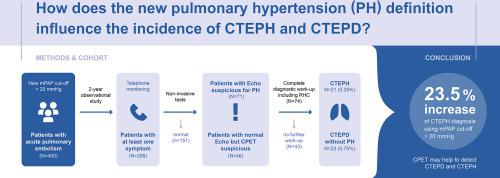Respiratory Medicine ( IF 3.5 ) Pub Date : 2023-03-01 , DOI: 10.1016/j.rmed.2023.107177
Matthias Held 1 , Elena Pfeuffer-Jovic 1 , Heinrike Wilkens 2 , Gülmisal Güder 3 , Franziska Küsters 1 , Hans Joachim Schäfers 4 , Heinz Jakob Langen 5 , Danjouma Cheufou 6 , Delia Schmitt 1

|
Background
The influence of the new pulmonary hypertension (PH) definition on the incidence of chronic thromboembolic PH (CTEPH) is unclear. The incidence of chronic thromboembolic pulmonary disease without PH (CTEPD) is unknown.
Objectives
To determine the frequency of CTEPH and CTEPD using the new mPAP cut-off >20 mmHg for PH in patients who have suffered an incidence of pulmonary embolism (PE) and were recruited into an aftercare program.
Methods
In a prospective two-year observational study based on telephone calls, echocardiography and cardiopulmonary exercise tests, patients with findings suspicious for PH received an invasive work-up. Data from right heart catheterization were used to identify patients with or without CTEPH/CTEPD.
Results
Two years after acute PE (n = 400) we found an incidence of 5.25% for CTEPH (n = 21) and 5.75% for CTEPD (n = 23) according to the new mPAP threshold >20 mmHg. Five of 21 patients with CTEPH and 13 of 23 patients with CTEPD showed no signs of PH in echocardiography. CTEPH and CTEPD subjects showed a reduced VO₂ peak and work rate in cardiopulmonary exercise testing (CPET). The capillary end-tidal CO2 gradient was comparably elevated in CTEPH and CTEPD, but it was normal in the Non-CTEPD-Non-PH group. According to the PH definition provided by the former guidelines, only 17 (4.25%) patients have been diagnosed with CTEPH and 27 individuals (6.75%) were classified having CTEPD.
Conclusions
Using mPAP >20 mmHg for diagnosis of CTEPH leads to an increase of 23.5% of CTEPH diagnosis. CPET may help to detect CTEPD and CTEPH.
中文翻译:

根据 mPAP 阈值 > 20 mm Hg 的 CTEPH 和 CTEPD 的频率和特征:来自前瞻性 PE 善后计划数据的回顾性分析
背景
新的肺动脉高压 (PH) 定义对慢性血栓栓塞性 PH (CTEPH) 发病率的影响尚不清楚。不伴 PH 的慢性血栓栓塞性肺病 (CTEPD) 的发病率尚不清楚。
目标
在发生肺栓塞 (PE) 并被纳入善后计划的患者中,使用新的 mPAP 临界值 >20 mmHg 确定 PH 的 CTEPH 和 CTEPD 的频率。
方法
在一项基于电话、超声心动图和心肺运动试验的前瞻性两年观察研究中,发现可疑 PH 的患者接受了侵入性检查。来自右心导管插入术的数据用于识别有或没有 CTEPH/CTEPD 的患者。
结果
急性 PE (n = 400) 两年后,根据新的 mPAP 阈值 >20 mmHg,我们发现 CTEPH (n = 21) 的发生率为 5.25%,CTEPD (n = 23) 的发生率为 5.75%。21 名 CTEPH 患者中的 5 名和 23 名 CTEPD 患者中的 13 名超声心动图未显示 PH 迹象。CTEPH 和 CTEPD 受试者在心肺运动测试 (CPET) 中显示出降低的 VO2 峰值和工作率。CTEPH 和 CTEPD的毛细血管呼气末 CO 2梯度相对升高,但在 Non-CTEPD-Non-PH 组中正常。根据之前指南提供的 PH 定义,只有 17 名(4.25%)患者被诊断为 CTEPH,27 名(6.75%)患者被归类为 CTEPD。
结论
使用 mPAP >20 mmHg 诊断 CTEPH 可使 CTEPH 诊断率增加 23.5%。CPET 可能有助于检测 CTEPD 和 CTEPH。

































 京公网安备 11010802027423号
京公网安备 11010802027423号